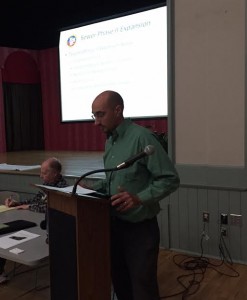SOUTHWICK – One important topic that will go to a vote at the special town meeting on Tuesday night at the Southwick-Tolland-Granville Regional High School auditorium will be approval of the $950,000 cost for the sewer line along Congamond Rd.
Before registered voters make their decision regarding the sewer line there is important information towards the project that needs to be laid out.
The whole sewer project cost includes the application to the USDA rural development, design, construction, and any contingencies. The total cost for the entire project is $3.8 million.
If the town did end up voting to have the brand new sewer line installed along Congamond Rd., the town of Southwick would secure interim financing in order to help reduce some of the costs.
The USDA Rural Development will also be able to give a long-term loan that could be up to 20% of the $3.8 million it costs for the entire project. This means that the town will be alone in paying for 80% ($2,560,000) of the entire project.
Quite possibly the biggest form of funding that DPW Director Randy Brown, and the rest of the town have been eyeing, is the MassWorks Infrastructure Program.
The Town of Southwick applied for the 2016 program and found out from MassWorks that they will not be receiving any funds for 2016. But, the $1.95 million grant will be available in the spring of 2017 where the town can apply yet again for the grant program to help take care of the sewer line costs.
There are two phases in the sewer line project. The first phase is installing the sewer line along Congamond Rd. near College Hwy to Miller Rd., which is just less than a mile long. Phase II consists of the Gillette Corner neighborhood which goes to the end of Congamond Rd.
The combination of about 80 customers or residences would be a part of the new sewer line.

DPW Director Randy Brown presented the details of the sewer line project to the community last week. (Photo by Greg Fitzpatrick)
The betterment, which recovers the project costs form the properties served, is an important part to the project. The town would collect the payments from the customers of Congamond Rd. and then make those payments towards the USDA Rural Development Loan.
Brown and the DPW were able to find out what the anticipated betterments would be for one EDU household.
With the $1.95 million MassWorks Grant, the range of what the betterment cost would be is anywhere from $12,000 to $16,000 per property. Without any grant funding, the betterment would range from $24,000 to $28,000 per property.
Customers of the sewer line have the option of paying these costs upfront in whole or they can pay more long term.
The long-term payment with the MassWorks grant would be a payment of at least $660 ever year ($55 per month) for 38 years. That cost would come out to $25,080. Without the MassWorks grant, Congamond Rd. customers would pay $1,320 each year ($110 per month) for 38 years, which would total to $50,160.
For a homeowner or business that has two EDU’s, the costs would be double the $25,080 or the $50,160, depending upon which option will be in effect for the project.
Brown wanted to reassure that those numbers are the projected numbers they were able to come up with.
“It could come in less than that, it could come in higher than that,” said Brown.
If the customers were to make a payment every year for the betterment, Brown explained what that would entail.
“It’s a long-term finance,” said Brown. “It’s not a lump-sum payment.”
Other factors that may affect the final betterment costs are the final construction costs, the percentage of grant money that will be awarded from USDA Rural Development, and other possible grants available.
Looking at the entire project, there are other costs to consider. The on-lot cost by the property owner includes connecting the sewer service to the stub at the property line as well as abandoning the septic tank.
According to Brown, the on-lot costs could range anywhere from $3,000 to $4,000, but those exact numbers are yet to be determined.
Once the service is extended, the customer will be subjected to their annual sewer use charge bill. The average homeowner cost annually on Congamond Rd. is around $400. The current sewer rate is $8.45 per every 1,000 gallons.
Brown addressed the importance it would be to act on the opportunity of having a new sewer line on Congamond Rd. now.
“This is the most cost-effective time to put that sewer system in place,” said Brown. “The longer we wait, the more cost it’s going to be.”

